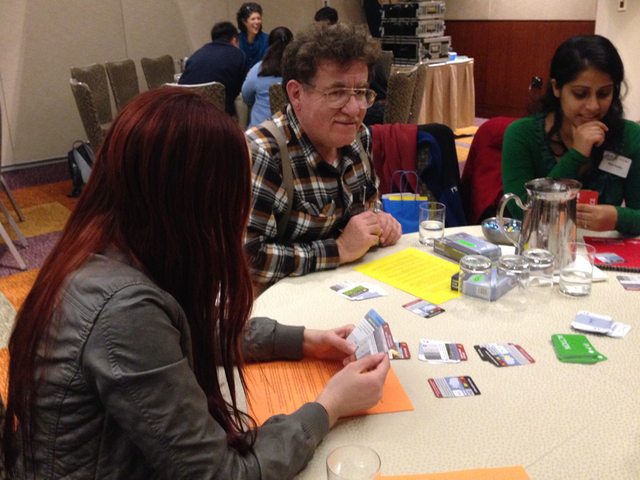This page is aimed at helping teachers use the Resource Library and Nexus card games in the classroom. The page contains a summary of the resources and games, a description of an activity (with examples) that combines the resources and games, and the context and learning goals of the activity.
Please also explore our pages that show how the activities align with the Common Core Standards and Next Generation Science Standards.
Summary
We have created an extensive resource library of articles and reports suitable for the high school to introductory college level on issues that surround the nexus of energy, water, and climate. The topic lends itself to rich discussions on complex systems about a critical issue facing society. There are three sections of the resource library:
- The Nexus of Water, Energy and Climate Concept: An overview
- Focus on the Nexus includes resources that describe the interconnectivity of energy, water, and climate and resulting issues;
- Nexus Resource Library contains readings on key manifestations of the nexus.
The resources have been chosen carefully to paint a full picture of the nexus concept, and to provide views and counterviews on related topics, such as the benefits of conventional and renewable energy technologies (e.g. coal, wind, solar, biofuels), unconventional water sources, and geoengineering. These readings can be mixed and matched to create thought-provoking and discussion-promoting experiences in undergraduate science courses with units on energy, water, and climate, or courses that teach about social, economic, and policy aspects of local or global nexus issues. Such learning materials, especially when used with opportunities for discussions, can promote critical thinking and problem-solving skills, argumentation and communication skills, and literacy in the breadth of energy, water, and climate issues affecting the world today.
In addition to the Nexus Resource library, the two educational card games, Thirst for Power and Challenge and Persuade, are available for play in class to complement the readings and to provide a structured, but fun, opportunity to learn and cement nexus concepts. By combining the readings and game play, students will gain a better sense of the issues and impacts surrounding the nexus, and how individuals, governments, and societies all play a role in potential solutions.
Description of the Activity
The activity uses a selection of readings from the Resource Library as focal points for teaching nexus concepts and issues, evaluating and developing arguments, and developing critical thinking skills through class discussions, writing assignments, and analyzing one or more texts on a given topic.
Any combination of articles could be used to teach about a particular technology, topic, or debate surrounding nexus issues. For example, the Resource Library is parsed out into nearly thirty topics from specific energy sources (conventional and renewable) to economic and health impacts and national security issues. For each topic, there is a list of readings that an instructor might select to create writing assignments and class discussions.
Below we list a few examples of article combinations that might be used to guide instruction on a given topic. These are only examples, and once you explore the Nexus Resource Library, you will find there are dozens of articles to choose from on any given topic. From these resources we hope that you create your very own activity customized to your needs.
To introduce or extend the activity, the two card games can be used to further develop students’ concepts and to increase their ability to consider different viewpoints, to see the big picture of nexus issues, and to determine factors that affect decisions and approaches to solving energy, water, and climate problems.
Example 1: Geoengineering
Geoengineering attempts to use our understanding of geosciences and Earth’s systems to control processes in Earth’s climate system in order to counteract the effects of global warming. Various perspectives on the geoengineering approaches are presented in a list of articles in the Nexus Resource Library.
Two well-written articles from the library, one by Spector1 and another by Hamilton2, could be used by students to explore many different pros and cons of geoengineering proposals. These articles are accessible, and require no previous knowledge of geoengineering. After reading these articles, students could weigh arguments, determine and compare author viewpoints, and construct a resulting argument of their own based on the readings.
Discussion points might include: Select one geoengineering idea, and discuss pros and cons. What are some long-term impacts that might result from geoengineering the planet?
References
1Spector, M. 2012. The Climate Fixers: Is there a technological solution to global warming? The New Yorker, 14 May 2012
2Hamilton, C. 2013. Geoengineering: Our Last Hope or a False Promise? New York Times, 26 May 2013
Example 2: Algae Biofuels
Algae can be used to produce biofuel, but there are many considerations to this technology. A list of articles in The Nexus Today section of the resource library explores pros and cons and the probability of producing and using algae biofuels as an alternative to fossil fuels.
Consider two articles, one by Gunther1 and the other by Werner2, that systematically review points for and against biofuels. From these articles, students can gain a broad perspective of the issues surrounding biofuels and draw on their own knowledge to make arguments and counterarguments for expending the time and resources to further develop algae biofuels for mass production.
Discussion points may include: What are the arguments and evidence against biofuels? What are the arguments and evidence for biofuels? What is a “carbon debt” and how can this debt be limited in biofuel production (types of answers may include using waste biomass or using degraded and abandoned agricultural lands to grow the biomass)? How do economics play a part in direct and indirect emissions of biofuel crops?
References
1Gunther, M. 2012. Green Crude: The Quest to Unlock Algae’s Energy Potential. Yale environment 360, 15 October 2012.
2Werner, C. 2008. Resolving the Biofuels Debate. Solar Today, Jul/Aug 2008.
How to use the Card Games

Fun for all ages!
Thirst for Power is a resource management game, where each player is the governor of a region that needs to provide for the energy needs of the citizens. All forms of energy generation use up water resources and have an environmental impact; each region has limited water and an environmental impact limit. The players each have their own strategy, and whichever player reaches the energy goals, using only available water resources and within the environmental impact limit wins. This game allows students to visualize and think about the relationships of energy and water and environmental impacts. For instance, hydrocarbon-based sources will get the player a lot of energy, but cost a lot of water and have a big environmental impact. Renewable sources use less water and have lower environmental impact, but generate less energy. The game improves critical thinking and reasoning skills.
Challenge and Persuade is a game of argumentation. Each player takes a turn acting as a Judge. Each round the Judge draws a card containing an adjective and the players are given three fact cards. Each player contrives an argument, using fact cards, previous knowledge, and the adjective. The Judge decides which argument wins. The game allows students the chance to construct, deconstruct, and evaluate arguments around nexus topics.
These games can be played in classrooms or in informal settings. Groups of 3-6 students can play. If using the games in conjunction with the readings, students should be encouraged to draw on the reading materials during game play. Written assignments or class discussions can easily be incorporated that allow students another chance to make or evaluate arguments and to consider and describe the complex issues at the nexus of energy, water, and climate.
Context
Type and level of course. These materials can be used in advanced high school and undergraduate science units on energy, water, and climate or courses that teach about social, economic, and policy aspects of issues at this nexus.
Background knowledge assumed in this assignment. Instructors are encouraged to set the stage for the readings, identifying terms, broad concepts, and the overall topic prior to the reading assignment. No other prior knowledge is necessary.
Skills required in this assignment. This assignment overall develops concept knowledge, critical thinking skills, argumentation skills, and communication skills.
Time required to complete the activity. At minimum, two class periods are recommended for this activity. Readings should be assigned as homework with one class period reserved for discussion; a second class period can be devoted to playing either one or both card games, followed by a debriefing and possible writing assignment based on knowledge and perspective gained during the game play.
Learning Goals
- To understand that society’s energy needs, water resources supply and demand, and drivers of climate change form a intertwined nexus.
- To gain perspective on the complexity of issues at this nexus, and that policies, science, and social and economic considerations all play significant roles in identifying potential solutions.
- To recognize that there is debate as to the best route to solving energy, water, and climate problems.
- To practice reading and summarizing important concepts; to recognize evidence-based arguments; to learn to structure and to make strong arguments; to make logical inferences from text; to analyze the structure of texts and the author’s purpose; and to compare two texts on the same theme.
